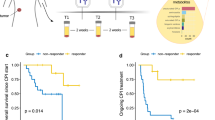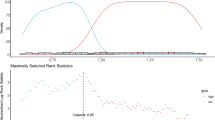Abstract
Our recent data have linked plasma phospholipid fatty acid (FA) profile in patients with non-Hodgkin’s lymphoma (NHL) with the clinical stage and aggressiveness of the disease. Thus, we proposed that plasma FA status in these patients may influence the effect of chemotherapy. The aim of this work was to assess FA status in NHL patients undergoing chemotherapy in relation to their response to therapy. We analyzed plasma FA profile in 47 newly diagnosed NHL patients before chemotherapy, after 3 cycles and after the end of the planned chemotherapy. Patients were treated according to the hospital protocol: 28 patients with cyclophosphamide, doxorubicin, vincristine and prednisone, 7 with other anthracycline-containing regimens, 4 patients with cyclophosphamide, vincristine and prednisone and 8 with fludarabine-based regimens. Rituximab was added in 22 patients. Ten patients who did not receive all planned chemotherapy due to death or toxicity (non-completers) had significantly lower (p < 0.05) baseline proportion of palmitoleic, linoleic, eicosapentaenoic and docosahexaenoic acid, as well as n-3 and n-6 FA, than the patients who completed chemotherapy (completers). Furthermore, the completers were divided according to the response to chemotherapy to complete remission (CR), stable disease and progressive disease (PD). Proportion of palmitic acid after the end of chemotherapy was the highest in the PD group, while stearic acid showed the opposite trend. Palmitoleic acid and all n-3 FA (18:3, 20:5, 22:5 and 22:6) were the highest in the patients in remission and the lowest in PD (p < 0.001). Linoleic acid decreased and arachidonic acid increased from the CR to the PD group (p < 0.001). These results suggest that aberrations in plasma FA may influence response to chemotherapy in patients with NHL.
Similar content being viewed by others
References
Cvetkovic Z, Cvetkovic B, Petrovic M, Ranic M, Debeljak-Martarcic J, Vucic V, et al. Lipid profile as a prognostic factor in cancer patients. J BUON. 2009;14(3):501–6.
Murphy RA, Wilke MS, Perrine M, Pawlowicz M, Mourtzakis M, Lieffers JR, et al. Loss of adipose tissue and plasma phospholipids: relationship to survival in advanced cancer patients. Clin Nutr. 2010;29(4):482–7.
Agatha G, Hafer R, Zintl F. Fatty acid composition of lymphocyte membrane phospholipids in children with acute leukemia. Cancer Lett. 2001;173(2):139–44.
McClinton S, Moffat LE, Horrobin DF, Manku MS. Abnormalities of essential fatty acid distribution in the plasma phospholipids of patients with bladder cancer. Br J Cancer. 1991;63(2):314–6.
Murphy RA, Bureyko TF, Mourtzakis M, Chu QS, Clandinin MT, Reiman T, et al. Aberrations in plasma phospholipid fatty acids in lung cancer patients. Lipids. 2012;47(4):363–9.
Zuijdgeest-van Leeuwen SD, van der Heijden MS, Rietveld T, van den Berg JW, Tilanus HW, Burgers JA, et al. Fatty acid composition of plasma lipids in patients with pancreatic, lung and oesophageal cancer in comparison with healthy subjects. Clin Nutr. 2002;21(3):225–30.
Lisboa AQ, Rezende M, Muniz-Junqueira MI, Ito MK. Altered plasma phospholipid fatty acids and nutritional status in patients with uterine cervical cancer. Clin Nutr. 2008;27(3):371–7.
Cvetkovic Z, Vucic V, Cvetkovic B, Petrovic M, Ristic-Medic D, Tepsic J, et al. Abnormal fatty acid distribution of the serum phospholipids of patients with non-Hodgkin lymphoma. Ann Hematol. 2010;89(8):775–82.
MacDonald N, Easson AM, Mazurak VC, Dunn GP, Baracos VE. Understanding and managing cancer cachexia. J Am Coll Surg. 2003;197(1):143–61.
Marra CA, de Alaniz MJ, Brenner RR. Modulation of delta 6 and delta 5 rat liver microsomal desaturase activities by dexamethasone-induced factor. Biochim Biophys Acta. 1986;879(3):388–93.
Pratt VC, Watanabe S, Bruera E, Mackey J, Clandinin MT, Baracos VE, et al. Plasma and neutrophil fatty acid composition in advanced cancer patients and response to fish oil supplementation. Br J Cancer. 2002;87(12):1370–8.
Purdue MP, Bassani DG, Klar NS, Sloan M, Kreiger N. Dietary factors and risk of non-Hodgkin lymphoma by histologic subtype: a case-control analysis. Cancer Epidemiol Biomarkers Prev. 2004;13(10):1665–76.
Harris NL, Stein H, Coupland SE, Hummel M, Favera RD, Pasqualucci L, et al. New approaches to lymphoma diagnosis. Hematology Am Soc Hematol Educ Program. 2001;2001(1):194–220.
Carbone PP, Kaplan HS, Musshoff K, Smithers DW, Tubiana M. Report of the committee on Hodgkin’s disease staging classification. Cancer Res. 1971;31(11):1860–1.
WHO. Obesity: preventing and managing the global epidemic. Geneva: World Health Organization; 2000.
Zilversmit DB, Davis AK. Microdetermination of plasma phospholipids by trichloroacetic acid precipitation. J Lab Clin Med. 1950;35(1):155–60.
Tepsic J, Vucic V, Arsic A, Blazencic-Mladenovic V, Mazic S, Glibetic M. Plasma and erythrocyte phospholipid fatty acid profile in professional basketball and football players. Eur J Appl Physiol. 2009;107(3):359–65.
Arsic A, Vucic V, Tepsic J, Mazic S, Djelic M, Glibetic M. Altered plasma and erythrocyte phospholipid fatty acid profile in elite female water polo and football players. Appl Physiol Nutr Metab. 2012;37(1):40–7.
Zhang J, Zhang L, Ye X, Chen L, Gao Y, Kang JX, et al. Characteristics of fatty acid distribution is associated with colorectal cancer prognosis. Prostaglandins Leukot Essent Fatty Acids. 2013;88(5):355–60.
Pandey M, Khatri AK, Dubey SS, Gautam A, Shukla VK. Erythrocyte membrane fatty acid profile in patients with primary carcinoma of the gallbladder. J Surg Oncol. 1995;59(1):31–4.
Evans LM, Cowey SL, Siegal GP, Hardy RW. Stearate preferentially induces apoptosis in human breast cancer cells. Nutr Cancer. 2009;61(5):746–53.
de Alaniz MJ, Marra CA. Role of delta 9 desaturase activity in the maintenance of high levels of monoenoic fatty acids in hepatoma cultured cells. Mol Cell Biochem. 1994;137(1):85–90.
Marzo I, Martinez-Lorenzo MJ, Anel A, Desportes P, Alava MA, Naval J, et al. Biosynthesis of unsaturated fatty acids in the main cell lineages of human leukemia and lymphoma. Biochim Biophys Acta. 1995;1257(2):140–8.
Pala V, Krogh V, Muti P, Chajes V, Riboli E, Micheli A, et al. Erythrocyte membrane fatty acids and subsequent breast cancer: a prospective Italian study. J Natl Cancer Inst. 2001;93(14):1088–95.
Fernandez E, Chatenoud L, La Vecchia C, Negri E, Franceschi S. Fish consumption and cancer risk. Am J Clin Nutr. 1999;70(1):85–90.
Polesel J, Talamini R, Montella M, Parpinel M, Dal Maso L, Crispo A, et al. Linoleic acid, vitamin D and other nutrient intakes in the risk of non-Hodgkin lymphoma: an Italian case-control study. Ann Oncol. 2006;17(4):713–8.
Grunfeld C, Feingold KR. Regulation of lipid metabolism by cytokines during host defense. Nutrition. 1996;12(1 Suppl):S24–6.
Spencer L, Mann C, Metcalfe M, Webb M, Pollard C, Spencer D, et al. The effect of omega-3 FAs on tumour angiogenesis and their therapeutic potential. Eur J Cancer. 2009;45(12):2077–86.
Simopoulos AP. Importance of the ratio of omega-6/omega-3 essential fatty acids: evolutionary aspects. World Rev Nutr Diet. 2003;92:1–22.
Tepsic J, Vucic V, Arsic A, Mazic S, Djelic M, Glibetic M. Unfavourable plasma and erythrocyte phospholipid fatty acid profile in elite amateur boxers. Eur J Sport Sci. 2013;13(4):414–21.
Xia SH, Wang J, Kang JX. Decreased n-6/n-3 fatty acid ratio reduces the invasive potential of human lung cancer cells by downregulation of cell adhesion/invasion-related genes. Carcinogenesis. 2005;26(4):779–84.
Acknowledgments
This work was supported by the Project III 41030 financed by the Ministry of Education, Science and Technological Development of the Republic of Serbia.
Conflict of interest
The authors declared no conflict of interest.
Author information
Authors and Affiliations
Corresponding author
Rights and permissions
About this article
Cite this article
Cvetković, Z., Vučić, V., Cvetković, B. et al. Distribution of plasma fatty acids is associated with response to chemotherapy in non-Hodgkin’s lymphoma patients. Med Oncol 30, 741 (2013). https://doi.org/10.1007/s12032-013-0741-2
Received:
Accepted:
Published:
DOI: https://doi.org/10.1007/s12032-013-0741-2




